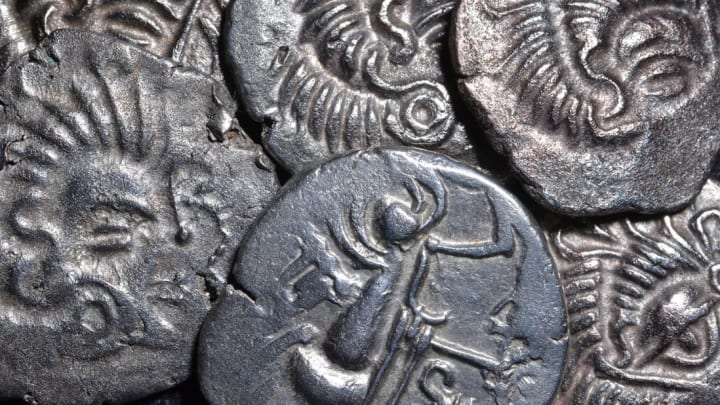Reg Mead and Richard Miles are proof that striking silver can be just as exciting as hitting gold—especially if the precious metal in question is a massive heap of ancient coins.
In the summer of 2012, the two amateur treasure hunters used metal detectors to discover the world’s largest-known Celtic coin hoard—now known as Catillon II—buried in a field on the Isle of Jersey in the British Channel Islands. The duo had spent more than 30 years searching for the rare stash, after a farmer’s wife (other accounts refer to her as a daughter) told them decades prior that her family had discovered silver coins while plowing a field.
Mead and Miles were granted limited access to the land, which they scoured after harvest season each year. Their persistence paid off when they finally found the treasure: nearly 70,000 Roman and Celtic coins, believed to date from around 30 to 50 BCE, along with some gold and silver jewelry, glass beads, a leather purse, and a woven silver-and-gold bag.




Long ago, members of a tribe called the Coriosolitae—who once lived in modern-day Brittany and Normandy in France—buried the wealth, presumably to hide it from the Romans.
The hoard was excavated by a team that was composed of members of local history and archaeology organizations Societe Jersiais and Jersey Heritage, along with staff from the Guernsey Museum, located on the island of Guernsey in the Channel Islands.
Removing the coin heap from the ground proved to be a challenge: "With earth still attached, it weighed over a ton," Neil Mahrer, a museum conservator with local historic trust Jersey Heritage, told Archaeology. "We had no idea how strong it was, in that it was only held together by the corrosion between the coins."


Once the treasure was finally unearthed, conservationists and volunteers spent around three years carefully extricating coins from the pile. The arduous project was completed in January 2017—and now, thanks to the magic of video editing, we can watch the entire process in only 30 seconds.
What happens next to the hoard is unclear. Such finds are protected by the Treasure Act.
[h/t Archaeology]
